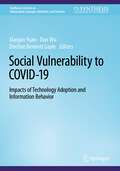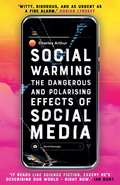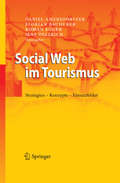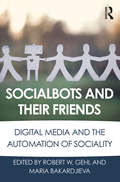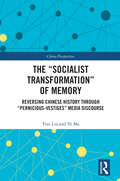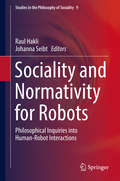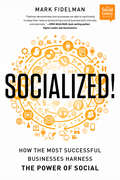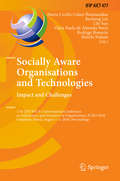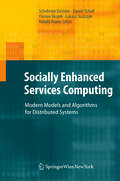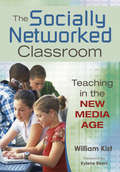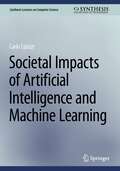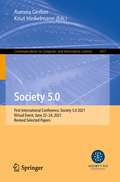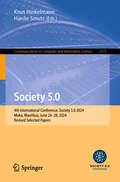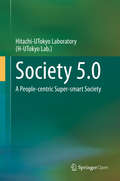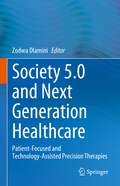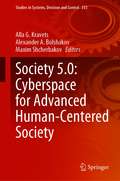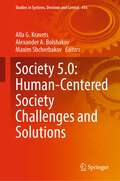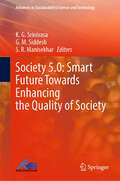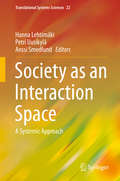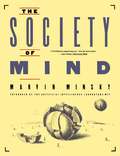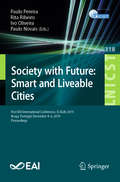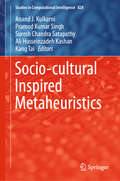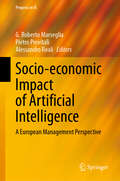- Table View
- List View
Social Vulnerability to COVID-19: Impacts of Technology Adoption and Information Behavior (Synthesis Lectures on Information Concepts, Retrieval, and Services)
by Dan Wu Xiaojun Yuan DeeDee Bennett GayleThis book provides an overview of the impact of the pandemic in China and the USA and presents a research agenda for use, access, and adoption of information and communication technologies (ICT) in the era of COVID-19. The global COVID-19 pandemic changed lives overnight and exposed socially vulnerable populations to ever-challenging situations. One significant challenge was the use, access, and adoption of technological resources. To understand how socially vulnerable populations managed the COVID-19 pandemic and adapt to the new normal, it is important for researchers and practitioners to identify the challenges and understand the perceptions of technologies. Through various research studies, this edited volume addresses the impact of the global COVID-19 pandemic and the adoption of technologies (from artificial intelligence to telehealth and telecommunications) among some socially vulnerable populations (including children, older adults, COVID-19 patients, and general marginalized populations) in the world. The information divide faced by socially vulnerable groups is studied as well as the dimension of vulnerabilities and the impacts of specific technologies.
Social Warming: The Dangerous and Polarising Effects of Social Media
by Charles ArthurNobody meant for this to happen. Facebook didn&’t mean to facilitate a genocide. Twitter didn&’t want to be used to harass women. YouTube never planned to radicalise young men. But with billions of users, these platforms need only tweak their algorithms to generate more &‘engagement&’. In so doing, they bring unrest to previously settled communities and erode our relationships. Social warming has happened gradually – as a by-product of our preposterously convenient digital existence. But the gradual deterioration of our attitudes and behaviour on- and offline – this vicious cycle of anger and outrage – is real. And it can be corrected. Here&’s how.
Social Web im Tourismus
by Florian Bauhuber Jens Oellrich Daniel Amersdorffer Roman EggerZiel der Autoren ist es, Mechanismen und Prinzipien des Social Webs im Tourismus aufzuzeigen. Neben den theoretischen Grundlagen erläutern sie die praktischen Anwendungen und illustrieren das Thema anhand vieler Best-Practice-Beispiele. Leser erfahren, welche Bedeutung das Social Web und seine grundlegenden Mechanismen haben, so dass Internet-Aktivitäten besser geplant und an neue Entwicklungen angepasst werden können. Für Akteure in der Tourismusbranche, aber auch Wissenschaftler, die einen Einstieg in die touristische Praxis des Social Web suchen.
Socialbots and Their Friends: Digital Media and the Automation of Sociality
by Robert W. Gehl Maria BakardjievaMany users of the Internet are aware of bots: automated programs that work behind the scenes to come up with search suggestions, check the weather, filter emails, or clean up Wikipedia entries. More recently, a new software robot has been making its presence felt in social media sites such as Facebook and Twitter – the socialbot. However, unlike other bots, socialbots are built to appear human. While a weatherbot will tell you if it's sunny and a spambot will incessantly peddle Viagra, socialbots will ask you questions, have conversations, like your posts, retweet you, and become your friend. All the while, if they're well-programmed, you won't know that you're tweeting and friending with a robot. Who benefits from the use of software robots? Who loses? Does a bot deserve rights? Who pulls the strings of these bots? Who has the right to know what about them? What does it mean to be intelligent? What does it mean to be a friend? Socialbots and Their Friends: Digital Media and the Automation of Sociality is one of the first academic collections to critically consider the socialbot and tackle these pressing questions.
The “Socialist Transformation” of Memory: Reversing Chinese History through “Pernicious-Vestiges” Media Discourse (China Perspectives)
by Yusi Liu Ye MaThrough discourse analysis and historical comparison of "Pernicious Vestiges" (Yí Dú/遗毒) narrative in the news text of People’s Daily, this book is devoted to revealing its primary metaphors and political functions in China. "Pernicious Vestiges" (Yí Dú/遗毒) is one of the most frequently used words in contemporary Chinese historical narration, as well as a constantly changing rhetorical direction in new China's media discourse, whose function is to remold memory. Over the past 76 years, the "Pernicious Vestiges" narrative continuously constructed by People’s Daily, the official newspaper of the CPC Central Committee, reflects the views of China’s political elite and represents the ruling party's evaluation and re-evaluation of historical events. The findings of this book challenge the myth that memory is naturally superior to forgetting, reflect on the ethics of memory in "Pernicious Vestiges" narratives and the erasure of their own justice, and suggest that the critical space compressed by "Pernicious Vestiges" narratives should be returned to restore the order of memory and historical reflection. This book will be an excellent read for students and scholars of Chinese studies, media studies, and those who are interested in political communication and collective memory in general.
Sociality and Normativity for Robots
by Raul Hakli Johanna SeibtThis volume offers eleven philosophical investigations into our future relations with social robots--robots that are specially designed to engage and connect with human beings. The contributors present cutting edge research that examines whether, and on which terms, robots can become members of human societies. Can our relations to robots be said to be "social"? Can robots enter into normative relationships with human beings? How will human social relations change when we interact with robots at work and at home? The authors of this volume explore these questions from the perspective of philosophy, cognitive science, psychology, and robotics. The first three chapters offer a taxonomy for the classification of simulated social interactions, investigate whether human social interactions with robots can be genuine, and discuss the significance of social relations for the formation of human individuality. Subsequent chapters clarify whether robots could be said to actually follow social norms, whether they could live up to the social meaning of care in caregiving professions, and how we will need to program robots so that they can negotiate the conventions of human social space and collaborate with humans. Can we perform joint actions with robots, where both sides need to honour commitments, and how will such new commitments and practices change our regional cultures? The authors connect research in social robotics and empirical studies in Human-Robot Interaction to recent debates in social ontology, social cognition, as well as ethics and philosophy of technology. The book is a response to the challenge that social robotics presents for our traditional conceptions of social interaction, which presuppose such essential capacities as consciousness, intentionality, agency, and normative understanding. The authors develop insightful answers along new interdisciplinary pathways in "robophilosophy," a new research area that will help us to shape the "robot revolution," the distinctive technological change of the beginning 21st century.
Socialized!: How the Most Successful Businesses Harness the Power of Social
by Mark FidelmanMost companies today realize the imperative to connect with their customers, employees, and partners through social technologies--Facebook, Twitter, Google+, YouTube, and elsewhere. But a huge challenge is still in the way: how to build programs and teams for accomplishing all that. While organizations have been fixated on how to use the latest social tool, they've lost sight of how to create a talent pool capable of adjusting to the next wave of technology around the corner. For corporations to successfully transform into social business enterprises they must shift the focus from computers and tools to developing skills and attitudes around technology. Socialized! represents a "playbook" on how to create such a high-performing social enterprise. Filled with clear strategies and real-life stories from visionaries and change makers, the book is designed to help leaders motivate employees throughout the organization to adopt a "social" mindset, ensuring success against the competition.
Socially Aware Organisations and Technologies. Impact and Challenges
by Maria Cecilia Calani Baranauskas Kecheng Liu Lily Sun Vânia Paula de Almeida Neris Rodrigo Bonacin Keiichi NakataThis book constitutes the refereed proceedings of the 17th IFIP WG 8. 1 International Conference on Informatics and Semiotics in Organisations, ICISO 2016, held in Campinas, Brazil, in August 2016. The 16 full papers and 9 short papers presented were carefully reviewed and selected from 30 submissions. The papers are organized in the following topical sections: organisational semiotics: theory and research; semiotics of interactions and socially aware user interface design; digital business ecosystems; knowledge management and engineering; and trends, challenges and new issues in education, health and eScience systems.
Socially Engaged Art in Contemporary China: Voices from Below (Routledge Research in Art and Politics)
by Meiqin WangThis book provides an in-depth and thematic analysis of socially engaged art in Mainland China, exploring its critical responses to and creative interventions in China’s top-down, pro-urban, and profit-oriented socioeconomic transformations. It focuses on the socially conscious practices of eight art professionals who assume the role of artist, critic, curator, educator, cultural entrepreneur, and social activist, among others, as they strive to expose the injustice and inequality many Chinese people have suffered, raise public awareness of pressing social and environmental problems, and invent new ways and infrastructures to support various underprivileged social groups.
Socially Enhanced Services Computing
by Florian Skopik Lukasz Juszczyk Daniel Schall Harald Psaier Schahram DustdarSocially enhanced Services Computing deals with a novel and exciting new field at the intersection between Social Computing, Service-oriented Computing, Crowd Computing, and Cloud Computing. The present work presents a collection of selected papers by the editors of this volume, which they feel will help the reader in understanding this field. The approach discussed allows for a seamless integration of people into trusted dynamic compositions of Human-provided Services and Software-based services, thus empowering new interaction models and processes in massive collaboration scenarios in a Future Internet.
The Socially Networked Classroom: Teaching in the New Media Age
by William R. KistIncorporate social networking into instruction, no matter your level of technological expertise or Internet access! With appropriate guidance, students’ social networking skills can be harnessed for teaching and learning in the 21st century. William Kist demonstrates how pioneering teachers have successfully integrated screen-based literacies into instruction and provides: Real-world activities and lesson examples for Grades 5–12, with assignment sheets, assessments, and rubrics Ideas on fostering collaborative learning using blogs, wikis, nings, and other interactive media. Tips on Internet safety, blogging etiquette, protected blogging sites, and more Blog entries from classroom teachers
Societal Impacts of Artificial Intelligence and Machine Learning (Synthesis Lectures on Computer Science)
by Carlo LipizziThis book goes beyond the current hype of expectations generated by the news on artificial intelligence and machine learning by analyzing realistic expectations for society, its limitations, and possible future scenarios for the use of this technology in our current society. Artificial Intelligence is one of the top topics today and is inflating expectations beyond what the technology can do in the foreseeable future. The future cannot be predicted, but the future of some elements of our society, such as technology, can be estimated. This book merges the modeling of human reasoning with the power of AI technology allowing readers to make more informed decisions about their personal or financial decisions or just being more educated on current technologies. This book presents a model that sketches potential future scenarios based on a discussion of the expectations today, the analysis of the current gap in the literature, and a view of possible futures in terms of technology and use cases. Specifically, this book merges literature on the technology aspects, the sociological impacts, and philosophical aspects.
Society 5.0: First International Conference, Society 5.0 2021, Virtual Event, June 22–24, 2021, Revised Selected Papers (Communications in Computer and Information Science #1477)
by Aurona Gerber Knut HinkelmannThis book constitutes revised and selected papers from the First International Conference on Society 5.0, Society 5.0 2021, held virtually in June 2021. The 12 full papers and 3 short papers presented in this volume were thoroughly reviewed and selected from the 54 qualified submissions. The papers discuss topics on application of the fourth industrial revolution innovations (e.g. Internet of Things, Big Data, Artificial intelligence, and the sharing economy) in healthcare, mobility, infrastructure, politics, government, economy and industry.
Society 5.0: 4th International Conference, Society 5.0 2024, Moka, Mauritius, June 26–28, 2024, Revised Selected Papers (Communications in Computer and Information Science #2173)
by Knut Hinkelmann Hanlie SmutsThis book constitutes of the revised selected papers from the 4th International Conference on Society 5.0, Society 5.0 2024, held in Moka, Mauritius, during June 26-28, 2024. The 29 full papers presented in this book were thoroughly reviewed and selected from a total of 76 qualified submissions. These papers discuss the various challenges and opportunities for a Society 5.0 in different areas, including Business Information Systems, Innovation and Entrepreneurship, Diversity, Innovation in the Digital Age, Healthcare and Care Systems, Information Security, Mobility, Human-System Interaction Scenarios, Fintech & International Collaborations.
Society 5.0: A People-centric Super-smart Society
by Hitachi-UTokyo LaboratoryThis open access book introduces readers to the vision on future cities and urban lives in connection with “Society 5.0”, which was proposed in the 5th Basic Science and Technology Plan by Japan’s national government for a technology-based, human-centered society, emerging from the fourth industrial revolution. The respective chapters summarize the findings and suggestions of joint research projects conducted by H-UTokyo Lab. Through the research collaboration and discussion, this book explores the future urban lives under the concept of “Society 5.0”, characterized by the key phrases of data-driven society, knowledge-intensive society, and non-monetary society, and suggests the directionality to which the concept should aim as Japan’s technology-led national vision. Written by Hitachi’s researchers as well as academics from a wide range of fields, including engineering, economics, psychology and philosophy at The University of Tokyo, the book is a must read for members of the general public interested in urban planning, students, professionals and researchers in engineering and economics.
Society 5.0 and Next Generation Healthcare: Patient-Focused and Technology-Assisted Precision Therapies
by Zodwa DlaminiThis book analyses the ability of technological advancements to represent, enhance, and empower multidisciplinarity in the context of Society 5.0. and next generation medicine. New technologies allow patients to communicate with medical personnel anytime, anywhere and shape the terrain of healthcare ecosystem at an unprecedented rate. Five main trends become apparent in this process: Hybrid care models combining virtual and in-person services, digitization of healthcare specialties, increased Artificial intelligence (AI) adoption, health systems moving to the cloud and advanced precision medicine.In its chapters the book dissects the important roles for technologies in areas such as digital twinning, big data, Internet of Things, AI, cyber-physical systems, blockchain technology to lead the healthcare digitalization envisioned in Society 5.0. Throughout the book the authors discuss how to incorporate these new technologies legally, ethically, safely, and securely and in keeping with the highest standards of human rights. It also advocates for the need for careful oversight and mindful allocation of resources and energy for sustainable development.This book, written by experts in the field from academia and industry, will appeal to researchers, healthcare professionals, policy makers, teachers and students interested in the ways healthcare is reorganized based on digital transformation efforts and the rethinking of care, including technologies.
Society 5.0: Cyberspace for Advanced Human-Centered Society (Studies in Systems, Decision and Control #333)
by Alla G. Kravets Alexander A. Bolshakov Maxim ShcherbakovThis book includes new findings on socio-economic cyber systems control and development approaches based on AI and data-driven techniques. The authors determine key social challenges and the main features of management and modeling processes. To enhance the efficiency of the socio-economic process, new approaches were suggested as well as its components based on the concept of Society 5.0. In this book, the authors substantiate the scientific, practical, and methodological approaches to the smart technologies’ development. The core is a human-centered concept of cyber systems as well as the intelligent paradigm. Approaches combined both mathematical models and data processing techniques are also proposed as advanced methods for smart system design for ecology and health care. The implementations of the developed prototypes, including testing in real domains, which have collected and analyzed big data and proved their effectiveness, are presented. The target audience of the book are practitioners, enterprise representatives, scientists, and Ph.D. and Master students who perform scientific research or applications of socio-economic cyber systems in different domains.
Society 5.0: Human-Centered Society Challenges and Solutions (Studies in Systems, Decision and Control #416)
by Alla G. Kravets Alexander A. Bolshakov Maxim ShcherbakovThis book focuses on open issues of Society 5.0, a new paradigm of a society that balances a human-centred approach and technologies based on cyber-physical systems and artificial intelligence. The book contains results of how intelligent or cyber-physical systems help to improve the quality of life in society despite new challenges. Discusses implemented breakthrough systems, models, programs, and methods that cover the following topics: biomedicine and healthcare, innovations in socio-economic systems, intelligent energetics, advances in transport systems, human-centric technologies. These approaches help to improve human society using cyber-physical systems in a dramatically changing environment. The target audience of the book are practitioners, enterprises representatives, scientists, PhD and Master students who perform scientific research on the application of cyber-physical systems towards Society 5.0.
Society 5.0: Smart Future Towards Enhancing the Quality of Society (Advances in Sustainability Science and Technology)
by K. G. Srinivasa G. M. Siddesh S. R. ManisekharThe book discusses Society 5.0 which fills the gap between cyber and physical space by providing a balanced environment between economic and social needs. The book is divided into two parts; part A focuses on various concepts related to Society 5.0 such as cyber space, physical space, information management and digital transformation. Part B discusses various integrated fields in Society 5.0, such as super-smart healthcare system, super-smart hospitality system, smart building, and transport management system. It also illustrates the concepts of big data, real-time analytics for smart Society 5.0 with an insight of real-time case studies.
Society as an Interaction Space: A Systemic Approach (Translational Systems Sciences #22)
by Anssi Smedlund Hanna Lehtimäki Petri UusikyläAs digitalization and social media are increasingly blurring the boundaries between traditional societal, political, and economic institutions, this book provides a cross-disciplinary examination of value co-creation. From various standpoints, it examines how institutions contribute to service ecosystems and how digitalization is transforming value co-creation in these ecosystems. Further, the book shares new perspectives on relational dynamics among government, companies, and citizens. These insights fill the gaps between service science and political science by integrating institutional logics into the concept of value co-creation. The book subsequently examines society as an interaction space. Topics discussed include the new logic and transformation mechanisms of economic activities, citizen participation, governance, and policy-making in the face of technological innovations, market-based reforms, and the risk of disconnect between citizens and policy-making. Here the focus is on value co-creation in complex adaptive systems where institutions, individuals, and businesses negotiate value and interests in networked relations. In closing, the book presents a range of empirical case studies on value co-creation, which provide examples of active networked citizenship, innovative governance and policy-making, democratic leadership, and trust-building dialogue among institutions. The studies address the context of Nordic countries, recognized as world-leading democracies. Pursuing a systems approach, the book articulates a social reality composed of interacting and interconnected elements that cannot be captured with only micro or macro levels of analysis. Service ecosystems are considered as configurations of people and technologies embedded in institutionalized rules, cultural meanings, and practices, offering valuable insights into the service-centered view of markets and society. Given the breadth and depth of its coverage, the book offers a valuable resource for all students and scholars interested in understanding and envisioning the future democratic landscape.
The Society of Mind
by Marvin MinskyMarvin Minsky -- one of the fathers of computer science and co-founder of the Artificial Intelligence Laboratory at MIT -- gives a revolutionary answer to the age-old question: "How does the mind work?" Minsky brilliantly portrays the mind as a "society" of tiny components that are themselves mindless. Mirroring his theory, Minsky boldly casts The Society of Mind as an intellectual puzzle whose pieces are assembled along the way. Each chapter -- on a self-contained page -- corresponds to a piece in the puzzle. As the pages turn, a unified theory of the mind emerges, like a mosaic. Ingenious, amusing, and easy to read, The Society of Mind is an adventure in imagination.
Society with Future: First EAI International Conference, SC4Life 2019, Braga, Portugal, December 4-6, 2019, Proceedings (Lecture Notes of the Institute for Computer Sciences, Social Informatics and Telecommunications Engineering #318)
by Rita Ribeiro Paulo Novais Paulo Pereira Ivo OliveiraThis book constitutes the refereed post-conference proceedings of the First International Conference on Society with Future: Smart and Liveable Cities, SC4Life 2019, which took place in Braga, Portugal, in December 2019. The 13 revised full papers were carefully reviewed and selected from 19 submissions. The conference has brought researchers, developers, and practitioners who are leveraging and develoing new knowledge on the topic of smart cities, offering more efficiency to main infrastructures, utilities and services, creating a sustainable urban environment that improves the quality of life for its citizens and enhances economic development.
Socio-cultural Inspired Metaheuristics (Studies in Computational Intelligence #828)
by Kang Tai Suresh Chandra Satapathy Anand J. Kulkarni Pramod Kumar Singh Ali Husseinzadeh KashanThis book presents the latest insights and developments in the field of socio-cultural inspired algorithms. Akin to evolutionary and swarm-based optimization algorithms, socio-cultural algorithms belong to the category of metaheuristics (problem-independent computational methods) and are inspired by natural and social tendencies observed in humans by which they learn from one another through social interactions. This book is an interesting read for engineers, scientists, and students studying/working in the optimization, evolutionary computation, artificial intelligence (AI) and computational intelligence fields.
Socio-economic Impact of Artificial Intelligence: A European Management Perspective (Progress in IS)
by G. Roberto Marseglia Pietro Previtali Alessandro RealiThis edited volume discusses ethical issues raised by the use of artificial intelligence (AI) in business. Written by academics and practitioners across Europe, this volume provides a regional management perspective on the consequences of AI, including potential effects on the business models of companies, strategic considerations regarding the construction of data-literate companies and workforces, and the limits and opportunities of proposed EU regulations. Providing a forum to hypothesise solutions for accelerating technology adoption while guaranteeing human dignity, this book will be valuable for researchers and students interested in management, AI, fintech, information systems, and sustainable business as well as managers and practitioners navigating the challenges of a data-driven future.
Socio-Environmental Research in Latin America: Interdisciplinary Approaches Using GIS and Remote Sensing Frameworks (The Latin American Studies Book Series)
by Santiago LópezThis contributed volume presents relevant examples of socio-environmental research that highlight the challenges and opportunities of using geotechnologies in interdisciplinary settings across the vast, culturally, and environmentally mega-diverse region known as Latin America. While remote sensing has been mostly used for mapping and monitoring physical features, geographic information systems open up opportunities for the integration of socio-economic and environmental data collected through individual and community-based surveys, in-situ measurements, and other participatory research techniques to offer additional analytically grounded power when evaluating socio-environmental processes that shape Latin American landscapes. The topics addressed in this book include deforestation and land degradation, borderlands dynamics, agriculture and agroecological systems, environmental conservation and development, public health, tourism, environmental justice, archeology, volunteered geography and urban planning, among others. The book is intended for academics, graduate and undergraduate classrooms, and general audiences with interest in Latin America and the socio-environmental issues that threaten the sustainability of the region and local communities. The book will also appeal to practitioners, managers, and policy makers interested in the application of geo-technologies and field-based research to address complex socio-environmental problems in the Global South.
